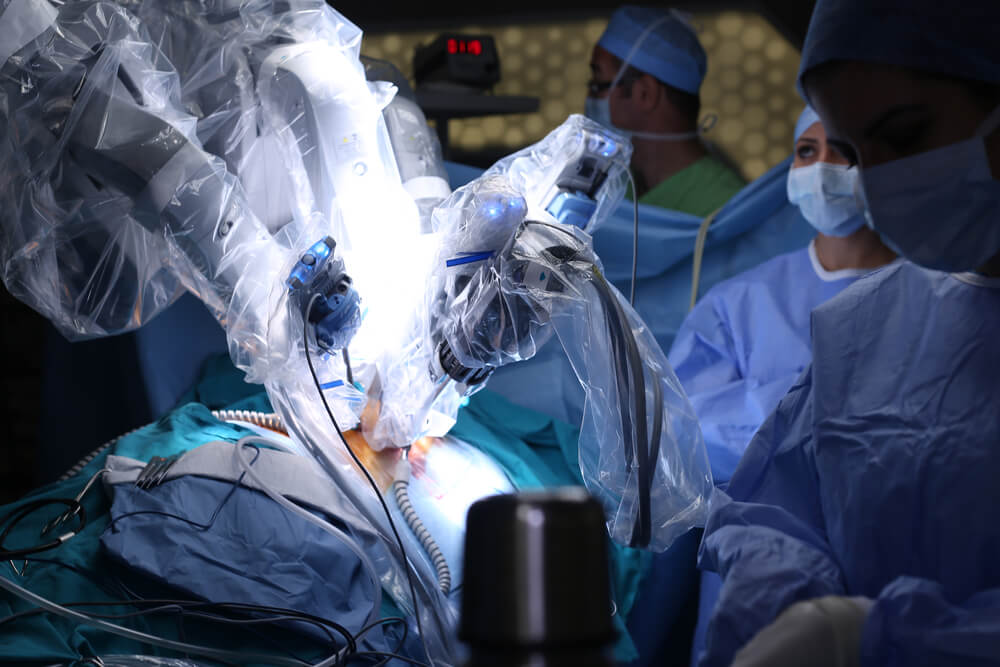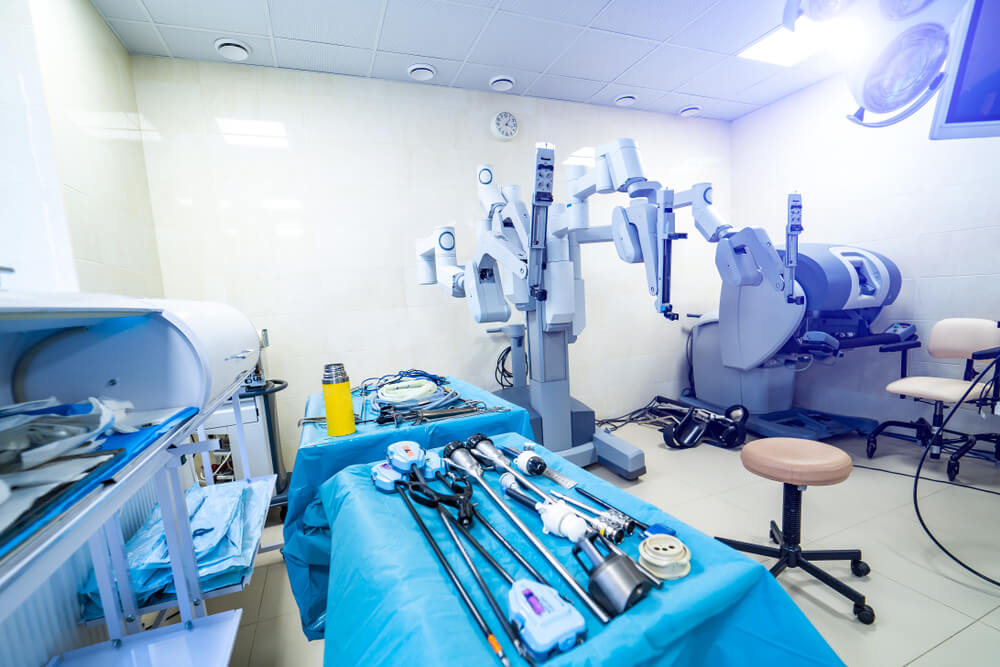The da Vinci robot has revolutionized the field of laparoscopic surgery. Its precision and flexibility make it a valuable tool for surgeons in various specialties, including gynecology.
In this expert article, we will explore the countless benefits of the da Vinci procedure and how robotic surgery is used in gynecology. However, it is essential to note that this is a highly specialized field, and it is crucial to consult with a professional da Vinci OBGYN for proper evaluation and treatment.
If all of this sounds good and you are ready to learn more, keep scrolling to find out everything you want to know about da Vinci robotic surgery.
Da Vinci Procedure Defined

The da Vinci procedure is a type of minimally invasive surgery that utilizes the da Vinci Surgical System, a robotic platform that allows for greater precision and control during surgery. The system consists of three main parts: the console, the vision cart, and the patient cart.
The console is where the skilled surgeon sits and controls the robotic instruments. The surgeon operates the console using hand and finger movements while viewing the surgical site through a high-definition 3D camera system located on the vision cart. The vision cart provides the surgeon with a clear view of the surgical site and is equipped with monitors that display the images captured by the camera system.
Finally, the patient cart holds the robotic arms that are controlled by the surgeon through the console. These arms can be fitted with various surgical instruments inserted into the patient’s body through small incisions. The da Vinci system’s robotic arms can rotate 360 degrees and have greater dexterity than human hands, allowing for more precise movements during surgery.
Overall, the da Vinci procedure and the da Vinci Surgical System offer several benefits to patients, including smaller incisions, reduced blood loss, and faster recovery times. It is important to remember that this procedure requires highly specialized training and expertise, and patients should consult with a da Vinci-certified surgeon for evaluation and treatment.
Open Surgery vs. Da Vinci Robotic Surgery: Differences Explained
Open surgery, also known as traditional surgery, involves making a large incision to access the surgical site. The surgeon then uses handheld instruments to perform the procedure. In contrast, da Vinci robotic surgery is a type of minimally invasive surgery that uses a robotic platform to perform the procedure. Some key differences between open surgery and da Vinci robotic surgery include the following:
Open Surgery:
- Involves a large incision
- Possibly increased blood loss
- Longer recovery time
- This could include a higher risk of complications such as infection and scarring (when performed by unskilled surgeons)
- Limited visualization of the surgical site
- Usually requires a more extended hospital stay
Da Vinci Robotic Surgery:
- Involves small incisions
- Reduced blood loss
- Faster recovery time
- Lower risk of complications
- Enhanced visualization of the surgical site with a 3D high-definition camera system
- Allows for greater precision and control due to the robotic instruments
- Shorter hospital stay
Overall, da Vinci robotic surgery offers several advantages over open surgery, including reduced trauma to the body, faster recovery times, and improved outcomes. Nevertheless, remember not all surgeries are suitable for the da Vinci robotic approach, and patients should consult with a qualified da Vinci-certified surgeon to determine the best course of treatment for their individual needs.
What are the Benefits of the Da Vinci Procedure?
The da Vinci procedure offers several benefits over traditional surgery techniques. Some of the key advantages include the following:
- Reduced risk of complications: The da Vinci robotic platform allows for greater precision and control during surgery, which can reduce the risk of complications such as bleeding and infection.
- Faster recovery times: Because the da Vinci procedure is minimally invasive, patients typically experience less pain and scarring and can often return to normal activities faster than with traditional surgery.
- Reduced blood loss: The robotic instruments used in the da Vinci procedure are designed to be more precise, which can reduce the amount of blood loss during surgery.
- Enhanced visualization: The da Vinci platform includes a 3D high-definition camera system that provides the surgeon with a clear view of the surgical site. This enhanced visualization can help the surgeon identify and avoid delicate structures, reducing the risk of injury.
- Increased precision and control: The da Vinci platform’s robotic instruments have greater dexterity than human hands, which allows the surgeon to perform complex maneuvers with greater precision and control.
- Smaller incisions: The da Vinci procedure uses small incisions, which can reduce scarring and minimize trauma to surrounding tissues.
Robotic Surgery in Gynecology: Must-Know Facts
The da Vinci robot can perform various surgical procedures in various specialties, including gynecology. Here is what you need to know about robotic surgery in gynecology:
- Hysterectomy: The da Vinci robot is commonly used to perform hysterectomy procedures involving removing the uterus. This minimally invasive approach can reduce scarring, blood loss, and recovery time compared to traditional open surgery.
- Endometriosis: The da Vinci system can be used to remove endometrial tissue, which can cause painful symptoms for some women.
- Fibroids: The da Vinci robot can be used to remove uterine fibroids, which are non-cancerous growths that can cause pain and other symptoms.
- Pelvic pain: The da Vinci system can be used to diagnose and treat pelvic pain by examining the pelvic area and performing surgical procedures as needed.
- Cancers: The da Vinci robot can perform cancer surgeries, such as a hysterectomy for cervical cancer or removal of the ovaries and fallopian tubes for ovarian cancer.
- Incontinence procedures: The da Vinci system can be used to perform procedures to treat urinary incontinence, such as a sling procedure.
While robotic surgery in gynecology is rising in popularity, here are some other conditions that the da Vinci robot can perform:
- Head and neck surgery: The da Vinci robot can remove tumors or perform reconstructive surgeries in the head and neck area.
- Colorectal surgery: The da Vinci robot can remove parts of the colon or rectum for conditions such as colon cancer or inflammatory bowel disease.
- Coronary artery bypass surgery: The da Vinci system can perform minimally invasive heart surgery, including bypass surgery.
Can You Get the Da Vinci Procedure Everywhere?

No, the procedure is not available everywhere. While the da Vinci surgical system is widely available across many countries, not all hospitals and healthcare facilities may have the resources or trained staff to perform the procedure.
Recovery and Outlook
The effectiveness of the procedure can vary depending on the specific surgery being performed and the patient’s individual health condition. However, in general, the robot has been shown to offer several advantages over traditional open surgery, including smaller incisions, reduced blood loss, and faster recovery times.
As mentioned before, patients who undergo this procedure may also experience less pain and scarring compared to open surgery, leading to a quicker return to daily activities and work.
Give Us a Call Today
If you are in need of compassionate and trained OBGYN care, look no further than our clinic. Our team of experienced providers is dedicated to providing personalized care to meet your unique needs. Book an appointment today.


